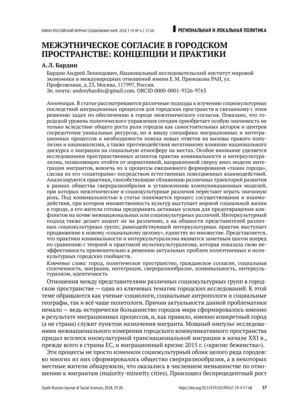Abstract
The article examines diverse approaches to the analysis of socio-cultural aftermath of migratory processes for urban spaces and the resulting attempt to solve the problem of ensuring interethnic consent. It is shown that the present-day level of urban political governance has become especially important not only due to the overall growth of the cities’ role as independent political and economic actors and centres with unique resources. It also happened in view of the specificity of migratory and integration processes and the necessity to search for new answers to the challenges of right-wing populism and nationalism, considering the opposition to the negative influence of the national discussion on migration upon local social climate. Emphasis is put on the analysis of spatial aspects of conviviality and inter-culturalism, which allows to abandon the normative downward model of the migrants’ integration. Instead, these practices help involve the migrants into everyday activity of creating “the city-cloth”, thus making them its “co-authors” through the natural day-by-day interaction. The article dwells upon practices that promote the convergence of different ways of development within the super-diversified society and the establishment of communication models in which interethnic and socio-cultural differences are no longer important. “Conviviality” is understood as “co-existence and interaction” process according to which the multiplicity of cultures is a norm of social life in the city and its residents are proactive in preventing inter-ethnic or socio-cultural conflicts. Similarly, the intercultural approach accentuates not differences but the commonality of different socio-cultural groups; the resultant of intercultural practices is advancement towards a new “social whole” — a unity in multitude. The author maintains that conviviality and inter-culturalism practices are a noticeable step forward in comparison with the theory and practice of multiculturalism that failed to effectively solve the urgent problems of poly-ethnic and poly-cultural urban communities.
Keywords
References
- Amin, A. (2012). Land of Strangers. Cambridge: Cambridge University Press.
- Buhr, F. (2018). Using the City: Migrant Spatial Integration as Urban Practice. Journal of Ethnic and Migration Studies, 44 (2), 307–320. DOI: 10.1080/1369183X.2017.1341715
- Gilroy, P. (2004). After Empire: Melancholia or Convivial Culture? London: Routledge.
- Hall, S. (2002). Political Belonging in a World of Multiple Identities. In Vertovec, S. & Cohen, R. (Eds.) Conceiving Cosmopolitanism: Theory, Context, and Practice (pp. 25–31). Oxford: Oxford University Press.
- Harvey, D. (2008). Pravo na gorod [Right to the City]. Logos. Retrieved from http://www.intelros.ru/pdf/logos_03_2008/04.pdf
- Heil, T. (2015). Conviviality: (Re)Negotiating Minimal Consensus. In Vertovec, S., (Ed.) Routledge International Handbook of Diversity Studies (pp. 317–324). Abingdon: Routledge.
- Interkulturelle Woche 2018. Programm Berlin (Auswahl) mit Hinweisen auf Veranstaltungen im Land Brandenburg. Retrieved from https://www.interkulturelle-woche-berlin.de/wp-content/uploads/2018/02/programmheft.pdf
- Jensen, T. G. (2016). The Complexity of Neighbourhood Relations in a Multiethnic Social Housing Project in Copenhagen. Identities, 23 (1), 84–98. DOI: 10.1080/1070289X.2015.1016519
- Katz, B. & Nowak, J. (2018). The New Localism. How Cities Can Thrive in the Age of Populism. Brookings Institution Press.
- Knowles, C. (2011). Cities on the Move: Navigating Urban Life. City: Analysis of Urban Trends, Culture, Theory, Policy, Action, 15 (2), 135–153.
- Lefebvre, H. (1996). Writings on Cities. Wiley-Blackwell.
- Massey, D. (2005). For Space. Sage Publications Ltd.
- Nowicka, M. & Vertovec, S. (2014). Comparing Convivialities: Dreams and Realities of Living-With-Difference. European Journal of Cultural Studies, 17 (4), 341–356.
- Radice, M. (2016). Unpacking Intercultural Conviviality in Multiethnic Commercial Streets. Journal of Intercultural Studies, 37 (5), 432–448. DOI:10.1080/07256868.2016.1211624
- Radice, M. (2015). Micro-Cosmopolitanisms at the Urban Scale. Identities, 22 (5), 588–602.
- Semenenko, I. S. (2018). Natsionalizm, separatizm, demokratiya… Metamorfozy natsional’noi identichnosti v “staroi” Evrope [Nationalism, Separatism, and Democracy. New Patterns of National Identity in “Old” Europe]. Polis. Politicheskie issledovaniya [Polis. Political Studies], 5, 70–87. DOI:10.17976/jpps/2018.05.07
- Tsapenko, I. P. (2017). Interkul’turnaya paradigma integratsii migrantov [Intercultural Paradigm of Migrant Integration]. Vestnik Rossiiskoi akademii nauk [Herald of the Russian Academy of Sciences], 87 (10), 915–926. DOI: 10.7868/S0869587317100061
- Vertovec, S. (2007). Super-Diversity and Its Implications. Ethnic and Racial Studies, 30 (6), 1024–1054. doi:10.1080/01419870701599465
- Wise, A. & Velayutham, S. (2013). Conviviality in Everyday Multiculturalism: Some Brief Comparisons Between Singapore and Sydney. European Journal of Cultural Studies, 17 (4), 406–430. doi:10.1177/1367549413510419
- Zukin, S. (1991). Landscapes of Power: From Detroit to Disney World. Berkeley: University of California Press.
 Русский
Русский


